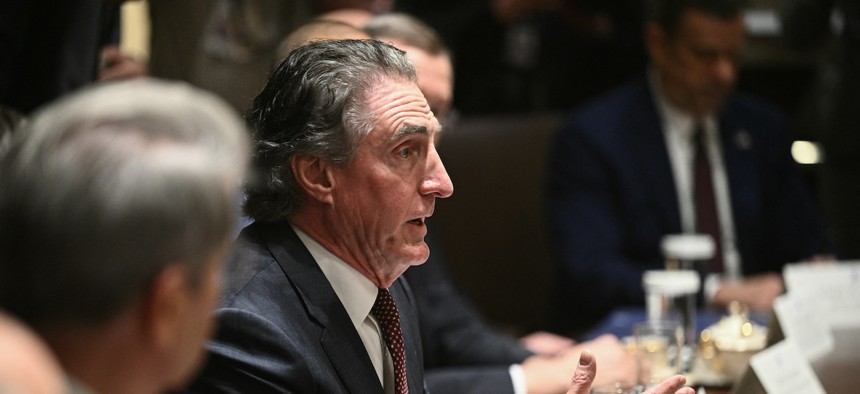
Interior Secretary Doug Burgum, shown here at a Cabinet meeting in early March, had a town hall meeting with department staffers on Wednesday. BRENDAN SMIALOWSKI/AFP via Getty Images
Interior Department to consolidate functions across the country, leading to widespread layoffs
Changes are expected to be implemented in the coming weeks.
The Interior Department is planning sweeping reductions to its administrative and support function workforce, according to several individuals briefed on the plan, and will consolidate those offices away from its component agencies.
Interior will fold areas such as IT, communications, finance, human resources and contracting into the central part of the department, rather than components such as the Bureau of Land Management, Fish and Wildlife Service and National Park Service maintaining their own cadres of staff to provide those services, four employees familiar with the plans said. That will be followed by widespread and significant reductions in force to employees in those offices, leading in some cases to 50% cuts to the relevant workforces.
Interior employees throughout its regional offices and down to the field office, station and park level are expected to feel the impacts of the consolidations.
The changes are expected to be announced within weeks. Interior, like many agencies, reopened the “deferred resignation program” for employees to take paid leave through September before leaving government. That window closes Wednesday. After the department assesses how many employees took advantage of that and other incentives to voluntarily leave government, it is expected to quickly make a final determination on cuts and institute its changes.
“Under President Donald J. Trump’s leadership, the department is working to right-size the federal workforce, cut bureaucratic waste, and ensure taxpayer dollars are spent efficiently,” said J. Elizabeth Peace, a department spokesperson. “We will continue working with the Office of Personnel Management and other agencies to implement cost-saving measures that put taxpayers first while ensuring the responsible stewardship of America’s natural and cultural resources.”
Staff in affected offices, having been warned of the upcoming cuts by leadership in their respective bureaus, have opted into the “DRP 2” offer at an increasingly high rate, employees said. One impacted worker said of his regional team expected to be swept up in the consolidation and accompanying RIF, at least 75%—and possibly everyone—will take the deferred resignation.
Many top career leaders at Interior are also taking the DRP offer, while others were recently fired for clashing with Department of Government Efficiency personnel over access to a key personnel system. DOGE is spearheading the consolidation effort at the department, according to multiple employees.
In a possible preview of who will be spared from layoffs, Interior exempted positions related to wildland fire, on-site park and refuge work, Indian Affairs, law enforcement, permitting and aviation, among others, from taking the DRP offer.
Employees predicted the department and its bureaus would lose out on subject matter expertise. Workers covering issues at the regional level of FWS or BLM, for example, often deal with technical and specific issues that will be difficult to cover from a centralized, broad perspective. They suggested the remaining staff—many of whom will be under increased scrutiny under the Trump administration’s new Schedule Policy/Career designation—will be subject to more politicized messaging and operations.
“A lot of the department’s and associated bureaus’ work is highly technical,” one employee said. “Those nuances and expertise will be lost.”
Employees stressed much of their work is public facing and that population will see services degraded as a result of the cuts.
At a town hall on Wednesday, Interior Secretary Doug Burgum asked employees to work more efficiently and deliver more revenue to the government.
“I invite you and challenge all of you to help us make that work even more purposeful, more efficient, more effective,” Burgum said. “Help us serve our customers better than we have in the past. Help us drive our costs down and our revenue up.”
He added that AI could help get rid of "bureaucratic rules” at the department.
“It could certainly change how much fun we have every day,” Burgum said. “It could change how we think about driving things forward.”
How are these changes affecting you? Share your experience with us:
Eric Katz: ekatz@govexec.com, Signal: erickatz.28
Sean Michael Newhouse: snewhouse@govexec.com, Signal: seanthenewsboy.45
Erich Wagner: ewagner@govexec.com; Signal: ewagner.47
NEXT STORY: House Republicans object to GOP budget for not cutting enough spending







